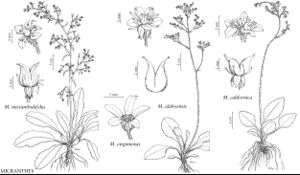Micranthes micranthidifolia
Fl. S.E. U.S., 501, 1331. 1903 ,.
Plants solitary or in groups, with bulbils on caudices. Leaves basal; petiole ± indistinct, (broad), flattened, 3–15 cm; blade lanceolate to oblanceolate, 4–35 cm, thin, base attenuate, margins irregularly serrate to dentate, ciliate, surfaces sparsely hairy. Inflorescences (30–) 50+–flowered, very open, lax thyrses, 30–75 cm, pink to purplish-tipped stipitate-glandular; (bracts gradually smaller distally). Flowers: sepals strongly reflexed, oblong; petals white, with 2 basal yellow spots that sometimes appear as 1 (sometimes faded in dried material), ± elliptic to spatulate, clawed, 2–3 mm, longer than sepals; filaments strongly club-shaped; pistils distinct almost to base; ovary superior, (to 1/3 adnate to hypanthium). Capsules green, sometimes purplish, folliclelike. 2n = 22.
Phenology: Flowering spring.
Habitat: Rocky seepage slopes, stream banks
Elevation: 400-2100 m
Distribution

Ga., Ky., Md., N.C., Pa., S.C., Va., W.Va.
Discussion
Micranthes micranthidifolia was formerly gathered by local people in the southern Appalachians as a spring “green” (hence the common name, “branch” being dialect for a small stream); it is still occasionally seen in local grocery stores.
Selected References
None.
Lower Taxa
"thin" is not a number."full" is not a number.
